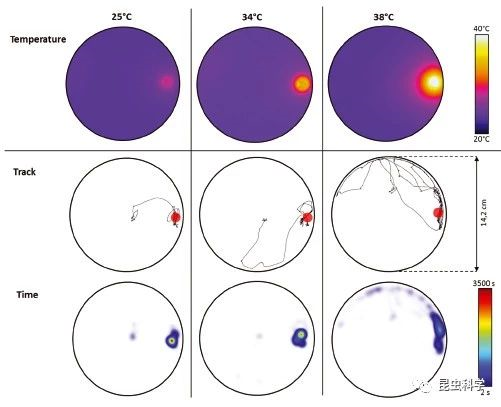本研究调查了丝光绿蝇Lucilia sericata幼虫(双翅目:丽蝇科)这种取食脊椎动物尸体的尸食性昆虫的温度调节行为。
丝光绿蝇幼虫需要较高的热能输入才可发育,并且可通过形成大型聚集体而提高温度。我们推测,丝光绿蝇幼虫在接近38℃的高温(在幼虫体内可达到这一温度)下应当可继续取食。并推测,它们具有温度调节行为,如在较热的食物投放点和较冷的区域间活动。
为验证这些推测,本研究跟踪记录单头饥饿的3龄幼虫1小时内在培养皿中的活动,培养皿中分别设置1个温度为25℃,34℃或38℃恒温的食物投放点(food spot, FS)。还要验证同一物种在食物中的先期活动对幼虫行为的影响。通过解剖幼虫嗉囊来监测消化系统中的食物含量。
根据嗉囊中食物的相对含量(relative crop measurement)判断,幼虫可在所有食物温度下取食,但是温度强烈影响幼虫的行为和运动。在食物投放点温度较高时,幼虫在含1个食物投放点的培养皿中活动的总时间和每次停留的时间缩短。同种个体在食物中的先期活动略微增加了幼虫在食物点中的时间,并缩短了离食物投放点的平均距离。因此,尸食性昆虫丝光绿蝇幼虫可能在正常取食活动中通过适应局部温度变化(尤其是在蛆虫内部)进行温度调节。通过维持稳定的体内温度,幼虫可缩短其发育时间。

Fig. 4Visualization of 3 sample trials with food spots at different temperatures (from left to right: 25°C, 34°C, and 38°C). The top row shows thermal imaging of the arena according to a color scale ranging from deep blue (20°C) to white (40°C) (T420 Infra-red camera,ɛ=0.94, FLIR®Systems, Inc Wilsonville, USA). The middle row shows the tracking of the larva, with FS a red spot located to the right in the arena. The larva traveled a total distance of 138.4, 155, and 661.7 cm at 25°C, 34°C, and 38°C, respectively. The bottom row shows the location of time spent in the arena according to a color scale: white, the larva was not there; blue, indicating a short stay (2 s); and red, a long stay (3500 s). Total time spent in FS was 2981, 2598, and 116 s at 25°C, 34°C, and 38°C, respectively.
转自昆虫科学